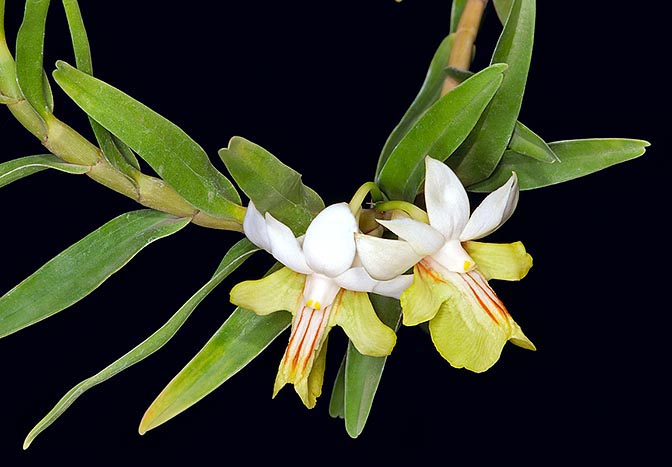Family : Orchidaceae

Text © Pietro Puccio

English translation by Mario Beltramini

Dendrobium uniflorum solitary flowers generate at the pseudobulbs nodes and last almost a month © Giuseppe Mazza
The species is native to south-eastern Asia (Borneo, Malaysia, Philippines, Sulawesi, Sumatra, Thailand and Vietnam), where it grows in the evergreen humid forests up to about 800 m of altitude.
The name of the genus is the combination of the Greek terms “déndron” = tree and “bios” = life, with reference to the numerous species of the genus living on the trees; the name of the species is the combination of the Latin terms “unus” = one, unique, and “flos, -oris” = flower, with reference to the solitary flowers at the nodes of the pseudobulbs.
Common names: single-flowered Dendrobium (English).
The Dendrobium uniflorum Griff. (1851) is an epiphytic species with cylindrical, erect or semi-pendulous pseudobulbs, up to about 60 cm long with a diameter of 0,7 cm, and numerous oblong-lanceolate leaves, alternate and distichous, coriaceous, bilobed at the apex, 3-6 cm long and 0,6-1,2 cm broad.
Solitary flowers, opposed to the leaves, on an about 3 cm long peduncle, with pure white sepals and petals and greenish yellow labellum with white central zone, usually crossed at the centre by three brown reliefs. The sepals are ovate with pointed apex, 2,5 cm long and about 1 cm broad, the lateral ones joined at the base forming a sort of a spur (mentum), about 0,7 cm long, ovate petals, 1,3 cm long and 0,6 cm broad, trilobed labellum, 3 cm long and 3,5 cm broad, with obovate lateral lobes, about 1,4 cm long, and obcordate median lobe with margins facing backwards; the flowers are long-lasting, about 3-4 weeks.
It reproduces by seed, in vitro, by micropropagation and by division, to be done at the vegetative restart, with each section provided with at 3-4 pseudobulbs at least. Species easy to cultivate in warm-temperate climate, with lowest temperatures in winter over the 14 °C, even if it can tolerate some degree less for a very short time and if dry, high luminosity, also some hours of direct sun, humidity, 60-80% and a good and constant ventilation.
It does not have a precise period of rest, the waterings must be therefore regular and abundant, even if a slight reduction in winter is wise until the vegetative restart.
For the waterings and the nebulisations is to be used rain water, or water obtained by reverse osmosis, or demineralised; the fertilizations, duly distributed in way to avoid salts accumulations, are to be done during the vegetative period preferably with hydrosoluble balanced products, with microelements, at ¼ of the dosage suggested on the package.
It can be mounted on bark, trunks, cork rafts or arborescent ferns roots rafts, or cultivated in pots or baskets with much draining and aerated compost, that can be formed by medium-sliced bark fragments with possible addition of inerts in order to improve the drainage.
→ For general notions about ORCHIDACEAE please click here.
